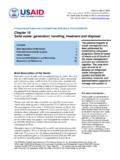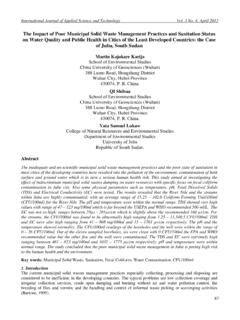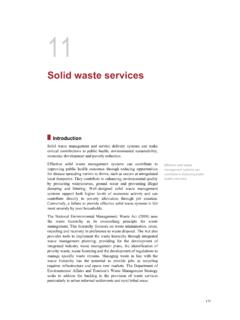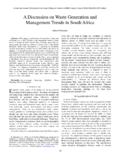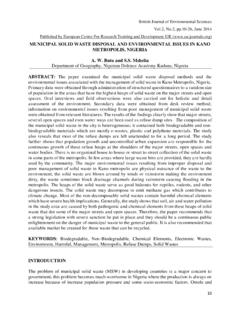Transcription of Solid Waste Management in Mumbai
1 Solid Waste Management in Mumbai Mumbai has a coastal stretch of 603 sq km. Geographically, the city of Mumbai can be divided into three sections, namely, the island city (or main city), the western suburbs and the eastern suburbs. These are also known for administrative purposes as Division I, Division II and Division III, respectively. The total population of the city amounts to nearly 13million that is increasing on a daily basis. Such a huge habitat obviously generates a huge amount of Waste of many kinds the Management of which is a massive task for the local administration. Waste Generation Mumbai generates Waste to the tune of approximately 7,025tonnes per day. The Waste consists of: 5,025tonnes of mixed Waste (bio-degradable and recyclable) 2,000tonnes of debris and silt.
2 The biodegradable Waste (wet Waste ) is made up of vegetable and fruit remainders, leaves, spoiled food, eggshells, cotton, etc. Recyclable (dry Waste ) consists of newspapers, thermocol, plastic, battery cells, wires, iron sheets, glass, etc. Debris includes construction Waste , renovation Waste , demolition Waste , etc. Silt comprises earth and clay from drains and road corners. It is estimated that by 2008 such Waste will aggregate 9,000tonnes per day due to increase in the city's population. Average Generation of Waste by a Citizen of Mumbai The generation of Waste by an individual depends on the socio-economic conditions to which the person belongs. For example, a rich family will generate nearly four to five kg of mixed Waste per day; a middle class family will generate between one to three kg of mixed Waste per day and a poor family, in slums, will generate close to 500grams per day.
3 Management of Waste The Municipal Corporation of Greater Mumbai (MCGM) is formally responsible for the Management of Waste in the city. The prevailing approach has been one of collection and disposal that is, garbage is collected from communities by the municipal authorities and disposed off at the three main dumping sites that are currently servicing the city. Garbage collectors employed by various housing societies manually collect the Waste generated at the household level and dump it in the garbage bin at specified street corners. There are around 5,800 community bins in the city. In case of South Mumbai , trucks collect garbage from the garbage bins and transport it to a transfer station which is located in Mahalakshmi.
4 A separate transport is arranged for transferring the garbage from Mahalakshmi to the northern part of Mumbai where the dumping grounds are situated. From all other parts of the city, garbage is sent directly to the dumping grounds. Nearly 95% of the Waste generated in the city is disposed off in this manner. This largely manual operation involves 35,000 personnel employed by the MCGM and is collected by a fleet of 800 vehicles, including vehicles hired from private contractors, that work in shifts each day. MCGM spends about Rs15-20lakh per day on collecting and transporting garbage and debris with municipal and private vehicles making about 2,000 trips every day. The Crisis Dumping Ground A dumping ground is, generally, a low-lying, and marshy area, which is located on the outskirts of a city, where there is, usually, no human population.
5 We have, in our city, three dumping grounds which are located in the northern part of Mumbai at Gorai (Borivali), Mulund and Deonar. A fourth one at Chincholi has recently closed down. Amongst the three, Deonar is the largest dumping ground. All the dumping grounds are nearly 30-40km from South Mumbai which explains the huge costs on transportation. The increase in the population of the city has forced people to settle near the dumping grounds. This has led to the twin problems of people living in unhealthy conditions and protesting for the closure of the dumping grounds, as dumping causes health hazards for the people in the vicinity. The average life of a dumping ground is 30 years. The remaining life of our largest dumping ground, , Deonar, is only five to six years and, so far, no alternative site has been found for Waste disposal.
6 The Waste , which offers an incentive after selling like paper, metal, etc., is sold to informal dealers by rag pickers. But the other organic Waste , old batteries, polystyrene (thermocol), polythene bags, debris, to name a few, do not have such incentives and these are in huge quantities. Also, since it takes a long time to decompose, when dumped, such Waste occupies and fills the low-lying areas. In fact, the search for a new dumping ground starts only when the filling area of the dumping ground is exhausted. Basically, the lower the Waste , the longer the life of the dumping ground and vice versa. The Waste at the dumping ground is covered with debris and spread evenly in layers. The organic Waste undergoes natural decomposition and generates a fluid, which is known a leachate, and is very harmful to the ecosystem, if not treated properly.
7 The leachate penetrates the soil and, if not prevented, pollutes the ground water. Also, flies, mosquitoes and many other pests breed on the Waste and unless properly maintained, the dumps are a public health hazard. Debris Disposal In Mumbai , every day 2,000tonnes of debris is generated officially, of which some part goes to the dumping ground for spreading over the organic garbage, as earth is expensive. The remaining debris is spread next to the roads, in the creeks, next to railway tracks and on open grounds. Every day, somewhere or the other, in some building, some renovation takes place, generating debris. This could be of houses or shops; it could be for repair of buildings or demolition of old buildings for reconstruction.
8 To give an example, if the external surface of a building of 20 floors is repaired, the Waste generated would be nearly 200 truckloads which can be used either in filling low-lying areas or for reclamation. Presently, there is no way of monitoring renovations and repairs because it does not need any permissions from authorities. The concerned housing societies give the permissions for the renovations / repairs; hence, no data is available on this. The only regulation, which has been imposed by the Corporation, is that the area where the repairs, renovations and new constructions have happened, needs to be cleaned up from all wastes, after the completion of work. There are truckers who earn a livelihood by collecting this debris and transporting it for disposal.
9 However, disposing it off properly remains a concern, as there is very little space in Mumbai . It has to be carted over long distances which increases transportation costs so significantly as to make the entire business unprofitable. So it is dumped clandestinely in the creeks, thus, destroying our valuable mangroves. As Mumbai has a coastal stretch of 603 sq. km, it has numerous creeks. These are channels of water which occupy marshy land during high tide. The salty water occupies the land during high tide and drains off during low tide. This nurtures plants called mangroves. These plants, in turn, have leaves which provide oxygen to the water for fishes to breed in the creeks. In many areas, like Versova, Gorai, Charkop and Mankhurd, the entire eco-system of the creek has been destroyed as Waste is dumped surreptitiously.
10 Increasing prices of land and more construction activities are forcing the demolition of old structures and building new structures and creating more debris wastes. Debris, being very bulky in nature, requires more space, reducing the life span of the dumping ground. Therefore, municipalities, generally, refuse the entry of debris into dumping grounds other than what they need to cover the garbage. Finding few viable alternatives, people just dump the debris by roadsides. Over time, people start dumping organic Waste on top of debris not only compounding the Waste disposal problem but also creating a health hazard. Garbage Collection - Low Serviced Areas The garbage collection activity itself has several differences amongst the localities; there are highly-serviced areas, medium-serviced areas and very low-serviced areas.


